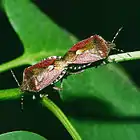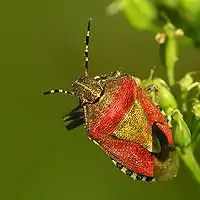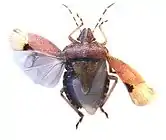| Dolycoris baccarum | |
|---|---|
 | |
| Adult of Dolycoris baccarum. Common form | |
| Scientific classification | |
| Kingdom: | |
| Phylum: | |
| Class: | |
| Order: | |
| Family: | |
| Genus: | |
| Species: | D. baccarum |
| Binomial name | |
| Dolycoris baccarum | |
| Synonyms | |
| |
Dolycoris baccarum, the sloe bug or hairy shieldbug,[1] is a species of shield bug in the family Pentatomidae.[2]
Distribution and habitat
This species is widespread in most of Europe and Central Asia.[3][4] These shield bugs mainly inhabit hedgerows and woodland edges, fields, forests, parks and gardens.[4][5]
Description
Dolycoris baccarum can reach a length of about 10–12.5 millimetres (0.39–0.49 in).[5][6] The basic color of pronotum and elytra is quite variable, but usually it is reddish purple, while scutellum is ocher. During the winter the basic color is dull brown. The whole body is quite hairy. The antennae are made by 4-5 black and white sections and the margins of the abdomen (connexivum) are alternately mottled with whitish and black.[4][5] The male and female are very similar. A related species encountered in Europe is Dolycoris numidicus.
Biology
It is univoltine in the northern part of the range and bivoltine in the warmer southern areas.[7] Adults of these shield bugs can be found all year around, as they overwinter. They emerge in the following spring, when they mate and females lay eggs. By the end of summer the new generation of adults appear. Nymphs feed on many plants, especially Rosaceae and Asteraceae species, Linaria vulgaris and Lamium album.[5][6] Adults can be found frequently on shrubs feeding on berries, especially Honeysuckle and Raspberries.[4] Despite the common name sloe bug, neither the larvae nor the adults feed on Sloe (Prunus spinosa).
Gallery
 Mating
Mating Mid nymph
Mid nymph.JPG.webp) Late nymph
Late nymph Adult. Red specimen
Adult. Red specimen Mounted specimen showing opened wings
Mounted specimen showing opened wings- Clip of Dolycoris baccarum in copula
References
- ↑ Dolycoris baccarum Hairy Shieldbug, British Bugs
- ↑ Biolib
- ↑ Fauna europaea
- 1 2 3 4 Garden Safari
- 1 2 3 4 British Bugs
- 1 2 "Commanster". Archived from the original on 2019-05-27. Retrieved 2017-06-21.
- ↑ Panizzi, Antônio R.; McPherson, J.E.; James, David G.; Javahery, M.; McPherson, Robert M. (2000). "Stink Bugs (Pentatomidae)". In Schaeffer, Carl W.; Panizzi, Antônio R. (eds.). Heteroptera Economic Importance. CRC Press. pp. 421–474. ISBN 0-8493-0695-7.